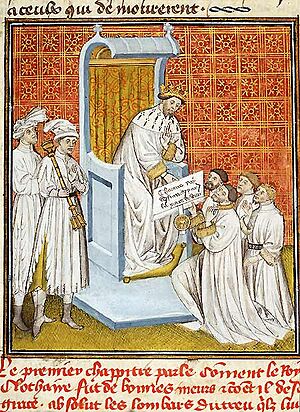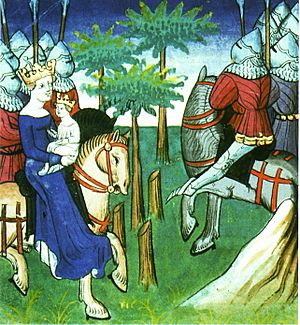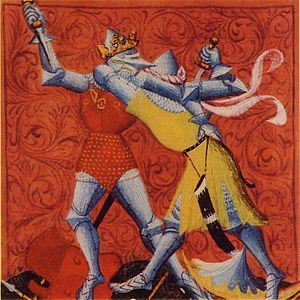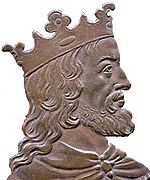Chlothar II facts for kids
Quick facts for kids Chlothar II |
|
|---|---|
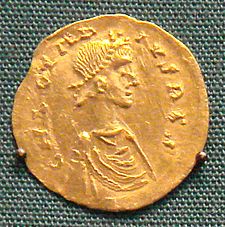
Coin of Chlothar II
|
|
| King of the Franks | |
| Reign | 613–629 |
| Predecessor | Sigibert II |
| Successor | Dagobert I as King of the Franks Charibert II as King of Aquitaine |
| King of Neustria | |
| Reign | 584–613 |
| Predecessor | Chilperic I |
| King of Paris | |
| Reign | 595–613 |
| Predecessor | Childebert II |
| Born | May/June 584 |
| Died | late 629 or early 630 (aged 45 or 46) |
| Spouse |
|
| Issue | Charibert II Dagobert I |
| House | Merovingian |
| Father | Chilperic I |
| Mother | Fredegund |
| Signature |  |
Chlothar II, also known as "the Young" (in French: le Jeune), was a powerful Frankish king. He was born in 584 and ruled until 629. His parents were King Chilperic I and Queen Fredegund.
He became king of Neustria when he was just a baby. His mother, Fredegund, ruled for him with help from his uncle, King Guntram of Burgundy. When his mother passed away in 597, Chlothar took full control. Neustria was a rich but small part of the Frankish lands.
Chlothar continued a long-standing conflict with Queen Brunhilda of Austrasia. This conflict was very fierce. In 613, Chlothar won a major battle. This victory allowed him to unite all the Frankish kingdoms under his rule.
His reign was quite long for that time. However, during his rule, the power of the king slowly became weaker. More power went to the Frankish nobles and the Church. In 614, he issued the Edict of Paris. This important law changed how the kingdom was run. In 617, he made the job of the mayor of the Palace a lifetime position. This was a big step in making this role very powerful. Eventually, the mayors of the palace would become kings themselves. In 623, Chlothar had to give control of Austrasia to his young son, Dagobert I.
Unlike many other Merovingian kings, Chlothar usually had only one wife at a time. He was generally friendly with the Church. His rule was not as violent as some of his relatives, except for the end of the conflict with Brunhilda.
Contents
Early Life and Family Background
Frankish Kingdoms in the 500s
Chlothar II's kingdom was part of the larger Frankish lands. These lands were first united by Clovis I, his great-grandfather. After Clovis died in 511, his kingdom was split among his four sons.
Later, in 550, Chlotar I (Chlothar II's grandfather) managed to unite the Frankish kingdom again. He also added the territory of Burgundy. But in 561, when Chlotar I died, his four sons divided the kingdom once more.
These divisions led to different Frankish kingdoms. The most important ones were Austrasia and Neustria. These names started to be used around 567.
Queen Fredegund's Plans
In 560, Chlothar's father, Chilperic, married a princess named Galswintha. She was the sister of Brunhilda, who married Chilperic's brother, Sigebert. However, Chilperic was in love with another woman, Fredegund.
Galswintha wanted to return to her home in Spain. In 568, she was killed. Soon after, Chilperic married Fredegund and made her queen. His brothers believed that Chilperic had ordered Galswintha's death.
This event started a long and bitter conflict. It was called the "royal feud" and lasted until Brunhilda died in 613. Fredegund also worked hard to secure her own position. She wanted to make sure her sons would inherit the throne.
Chlothar's Childhood
Frankish customs meant that babies were not named right away. This was to avoid bad luck. Chlothar's parents wanted to protect him. Their other sons had died very young. So, Chlothar was raised in secret in a royal house called Vitry-en-Artois.
In September 584, King Chilperic I was killed. This happened after a hunt. Many people believed Queen Brunhilda was behind it. Chilperic's death caused a lot of trouble. Other Frankish groups attacked Neustria and stole treasures.
Fredegund managed to keep most of the royal treasury. She also kept the loyalty of important leaders. She took her baby son, Chlothar, to Vitry. She sent a message to King Guntram of Burgundy. She asked him to adopt Chlothar and protect him. In return, Guntram would rule Neustria until Chlothar was old enough.
Guntram agreed to help. He called a meeting where Chlothar was recognized as Chilperic's son. They named him Chlothar, after his grandfather. Guntram then became Chlothar's godfather and legal guardian.
Fredegund was sent away for a time. But she managed to escape. She gathered support from nobles and bishops for her son. She was able to return to power. Guntram then made a deal with Brunhilda and her son, Childebert II. They agreed that if one king died, the other would inherit his kingdom. In 592, Guntram died, and Childebert became king of Austrasia and Burgundy.
This union of Austrasia and Burgundy did not last long. Childebert II died in 595. His kingdom was split between his two sons, Theudebert II and Theuderic II. These two brothers first fought against their cousin, Chlothar II of Neustria. But their alliance ended in 599, and they began fighting each other.
In 593, Chlothar was only nine years old. But he was present at the head of his army. His forces defeated an invading army from Austrasia. In 596, Chlothar and Fredegund took control of Paris. Fredegund, who was still ruling for her son, sent an army that defeated Theudebert and Theuderic's forces. Fredegund died in 597. Chlothar then began to rule Neustria on his own.
Chlothar as King of Neustria
Battle of Dormelles
In 599, Chlothar went to war against his nephews, Theuderic II of Burgundy and Theudebert II of Austrasia. They defeated him at Dormelles. This forced Chlothar to sign a treaty. It made his kingdom much smaller, limited to the regions of Beauvais, Amiens, and Rouen. The rest of his lands were divided between his nephews.
However, Theuderic and Theudebert soon started fighting each other. Chlothar often remained at war with Theuderic until Theuderic died in 613.
In 604, Chlothar tried to win back more of his kingdom, but he failed. His son, Merovech, was captured and killed. Around this time, Theuderic tried to marry a Spanish princess. This created new political tensions. Other kings, including the Lombards, formed an alliance against Theuderic.
War Between Austrasia and Burgundy (610–612)
In 610, Theudebert and Theuderic began a war. Theudebert won some early victories. This led Theuderic to ask Chlothar for help. Theuderic promised to give back northern Neustria to Chlothar if he helped. Theudebert was badly defeated in 612.
War Between Chlothar and Austrasia-Burgundy (613)
As promised, Theuderic gave northern Neustria back to Chlothar. But then Theuderic planned to invade Neustria. However, he died of an illness in 613. His troops scattered. Brunhilda then placed her great-grandson, Sigebert II, on the throne of Austrasia.
At this time, important leaders like Warnachar (the mayor of the palace of Austrasia) and Rado (mayor of the palace of Burgundy) turned against Brunhilda. They handed over the entire kingdom to Chlothar. Brunhilda and Sigebert tried to escape, but Chlothar's soldiers caught them. Chlothar ordered their execution. Brunhilda was accused of many crimes. After this victory, Chlothar became the sole ruler of all the Frankish people. He united the kingdoms under his power.
King of All Franks (613–629)
After uniting all the Frankish lands, Chlothar lived in Paris and nearby royal homes.
Mayors of the Palace
An important position in the Frankish kingdoms was the Mayor of the Palace. This person was originally in charge of the king's household. But during the royal feuds, their role became much more important. They became like chief managers of the lands. This position was often held by powerful nobles.
One famous Mayor of the Palace was Warnachar. He was the mayor of Burgundy in 613. He helped Chlothar capture Brunhilda. Warnachar held this powerful position until he died in 626.
The Edict of 614
In 614, Chlothar II called a meeting of important leaders in Paris. He then issued the Edict of Paris. This law gave many rights to the Frankish nobles. It also stated that Jewish people could not hold civil jobs for the king. This ban meant that the Church had more control over education and writing. It also pleased the nobles, as bishops were usually chosen from their ranks.
Article 11 of the Edict said its goal was to bring "peace and discipline" to the kingdom. It also aimed to "stop rebellion and disrespect." The Edict was approved for all three kingdoms. Because some officials had misused their power, the Edict also required that officials must come from the region they governed.
In 617, Chlothar was convinced by Warnachar and Rado to make the Mayor of the Palace a lifetime job. This happened near Paris.
Dagobert Becomes King of Austrasia (623)
In 623, Chlothar gave the kingdom of Austrasia to his young son, Dagobert I. This was a political move. It was a way to thank Bishop Arnulf of Metz and Pepin I, who were the most important nobles in Austrasia. By giving Dagobert the kingdom, these nobles gained a lot of power and independence.
At the same time, Chlothar changed some borders. He gave the region of Reims to Neustria. But Dagobert, now the king of Austrasia, negotiated to get it back in 626.
Relations with the Church
Chlothar was different from many other Merovingian kings. He did not practice polygamy (having many wives). Instead, he stayed loyal to one wife until she died. He respected the Church and its teachings. He kept the Church as an ally. He likely tried to be a good and religious king. He was probably inspired by his uncle Guntram, who had protected him and helped him become king.
In 617, he renewed a friendship treaty with the kings of the Lombards. He likely wanted to keep good relations with other Christian groups, as long as they also had good relations with the Church.
Death and Successors
Chlothar died in 629 when he was 45 years old. He was buried in Paris, like his father. His rule lasted longer than any other Merovingian king, except for his grandfather, Chlothar I.
Chlothar's son, Dagobert, who was already king of Austrasia, became king of Neustria and Burgundy. Chlothar's half-brother, Charibert, became king of Aquitaine.
Family
Chlothar II had children with his three wives.
His first wife was Haldetrude. They had:
- Merovech, who was captured and killed during a war.
- Emma, who married King Eadbald of Kent. Some historians think she might have been the daughter of another noble.
- Dagobert I (born around 603, died 639), who became King of the Franks.
His second wife was Bertrude. They likely had:
- A son who died as a baby in 617.
- Bertha, who married Warnachaire, the Mayor of the Palace of Burgundy.
In 618, he married Sichilde. They had:
- Charibert II (died 632), who became king of Aquitaine.
- Oda, a daughter.
Images for kids
-
Fredegund is cursed by Pretextatus, by Lawrence Alma-Tadema.
See also
 In Spanish: Clotario II para niños
In Spanish: Clotario II para niños



